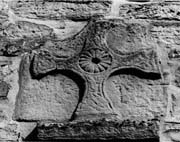Select a site alphabetically from the choices shown in the box below. Alternatively, browse sculptural examples using the Forward/Back buttons.
Chapters for this volume, along with copies of original in-text images, are available here.
Object type: Architectural feature(?) [1]
Measurements: H. c. 40 cm (15.75 in); W. c. 40 cm (15.75 in); D. Built in
Stone type: Apparently medium-grained, strong brown to red (7.5YR 5/6 to 2.5YR 4/6) sandstone; see no. 1.
Plate numbers in printed volume: 694
Corpus volume reference: Vol 3 p. 187
(There may be more views or larger images available for this item. Click on the thumbnail image to view.)
A once rectangular block carries an equal-armed cross of type D10, with wide arcs as arm-pits and cusped arms. There is a plain roll moulding round the perimeter. At the centre is a depression, a circular setting for an appliqué or crystal. From it radiate marigold petals in low relief. It is encircled by a thin plain moulding. The arms are filled with very worn interlace, now indistinct. The cross stands in bold relief.
This plaque may well have belonged to the early phase of the pre-Conquest church at the site, being reused in the eleventh-century tower (Taylor and Taylor 1965, I, 423). This is placed in the same position as the cruder version, Hovingham 4 (Ill. 484), which may be a copy of this fine piece.
The marigold and recess for a setting are closely paralleled on the small cross-head, at Lastingham (no. 4; Ills. 582–3), which is not far distant. The marigold motif occurs at Hexham, Northumberland (no. 22; Cramp 1984, 186, II, pl. 182, 972), and on one of the York Minster stelae (no. 19; Ill. 82). It is not often found in Hiberno-Saxon work, but does occur on the continent.



